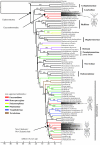Extreme convergence in stick insect evolution: phylogenetic placement of the Lord Howe Island tree lobster
- PMID: 19129110
- PMCID: PMC2679072
- DOI: 10.1098/rspb.2008.1552
Extreme convergence in stick insect evolution: phylogenetic placement of the Lord Howe Island tree lobster
Abstract
The 'tree lobsters' are an enigmatic group of robust, ground-dwelling stick insects (order Phasmatodea) from the subfamily Eurycanthinae, distributed in New Guinea, New Caledonia and associated islands. Its most famous member is the Lord Howe Island stick insect Dryococelus australis (Montrouzier), which was believed to have become extinct but was rediscovered in 2001 and is considered to be one of the rarest insects in the world. To resolve the evolutionary position of Dryococelus, we constructed a phylogeny from approximately 2.4 kb of mitochondrial and nuclear sequence data from representatives of all major phasmatodean lineages. Our data placed Dryococelus and the New Caledonian tree lobsters outside the New Guinean Eurycanthinae as members of an unrelated Australasian stick insect clade, the Lanceocercata. These results suggest a convergent origin of the 'tree lobster' body form. Our reanalysis of tree lobster characters provides additional support for our hypothesis of convergent evolution. We conclude that the phenotypic traits leading to the traditional classification are convergent adaptations to ground-living behaviour. Our molecular dating analyses indicate an ancient divergence (more than 22 Myr ago) between Dryococelus and its Australian relatives. Hence, Dryococelus represents a long-standing separate evolutionary lineage within the stick insects and must be regarded as a key taxon to protect with respect to phasmatodean diversity.
Figures



Similar articles
-
Detection and Differentiation of Entomopathogenic Serratia spp. to Inform Reintroduction of the Critically Endangered Lord Howe Island Stick Insect Dryococelus australis.J Wildl Dis. 2024 Apr 1;60(2):306-318. doi: 10.7589/JWD-D-23-00125. J Wildl Dis. 2024. PMID: 38243844
-
Museum Genomics Confirms that the Lord Howe Island Stick Insect Survived Extinction.Curr Biol. 2017 Oct 23;27(20):3157-3161.e4. doi: 10.1016/j.cub.2017.08.058. Epub 2017 Oct 5. Curr Biol. 2017. PMID: 28988864
-
Single origin of the Mascarene stick insects: ancient radiation on sunken islands?BMC Evol Biol. 2015 Sep 16;15:196. doi: 10.1186/s12862-015-0478-y. BMC Evol Biol. 2015. PMID: 26377339 Free PMC article.
-
The evolution of insect biodiversity.Curr Biol. 2021 Oct 11;31(19):R1299-R1311. doi: 10.1016/j.cub.2021.08.057. Curr Biol. 2021. PMID: 34637741 Review.
-
Phylogenetic divergence of island biotas: Molecular dates, extinction, and "relict" lineages.Mol Ecol. 2019 Oct;28(19):4354-4362. doi: 10.1111/mec.15229. Epub 2019 Sep 23. Mol Ecol. 2019. PMID: 31544990 Review.
Cited by
-
Comparative Mitochondrial Genomic and Phylogenetic Study of Eight Species of the Family Lonchodidae (Phasmatodea: Euphasmatodea).Genes (Basel). 2025 May 10;16(5):565. doi: 10.3390/genes16050565. Genes (Basel). 2025. PMID: 40428386 Free PMC article.
-
Speciation on oceanic islands: rapid adaptive divergence vs. cryptic speciation in a Guadalupe Island songbird (Aves: Junco).PLoS One. 2013 May 10;8(5):e63242. doi: 10.1371/journal.pone.0063242. Print 2013. PLoS One. 2013. PMID: 23675466 Free PMC article.
-
Positive selection in glycolysis among Australasian stick insects.BMC Evol Biol. 2013 Sep 30;13:215. doi: 10.1186/1471-2148-13-215. BMC Evol Biol. 2013. PMID: 24079656 Free PMC article.
-
Notes on the leaf insects of the genus Phyllium of Sumatra and Java, Indonesia, including the description of two new species with purple coxae (Phasmatodea, Phylliidae).Zookeys. 2020 Feb 19;913:89-126. doi: 10.3897/zookeys.913.49044. eCollection 2020. Zookeys. 2020. PMID: 32132850 Free PMC article.
-
A Cretaceous-aged Palaeotropical dispersal established an endemic lineage of Caribbean praying mantises.Proc Biol Sci. 2017 Sep 27;284(1863):20171280. doi: 10.1098/rspb.2017.1280. Proc Biol Sci. 2017. PMID: 28954908 Free PMC article.
References
-
- Bedford G.O. Defensive behaviour of the New Guinea stick insect Eurycantha (Phasmatodea, Phasmatidae, Eurycanthinae) Proc. Linn. Soc. NSW. 1976;100:218–222.
-
- Bradler S. The Australian stick insects, a monophyletic group within the Phasmatodea? Zoology. 2001;104(Suppl. IV (DZG 94.1)):69.
-
- Bradler S. Evolution of secondary ovipositors in stick insects (Insecta: Phasmatodea) Zoology. 2002;105(Suppl. V (DZG 95.1)):60.
-
- Bradler, S. In press. Phylogeny of the stick and leaf insects (Insecta: Phasmatodea). Species Phylogenet. Evol.
-
- Brakefield P.M. Evo–devo and constraints on selection. Trends Ecol. Evol. 2006;21:362–368. doi:10.1016/j.tree.2006.05.001 - DOI - PubMed
Publication types
MeSH terms
Substances
LinkOut - more resources
Full Text Sources
Molecular Biology Databases

